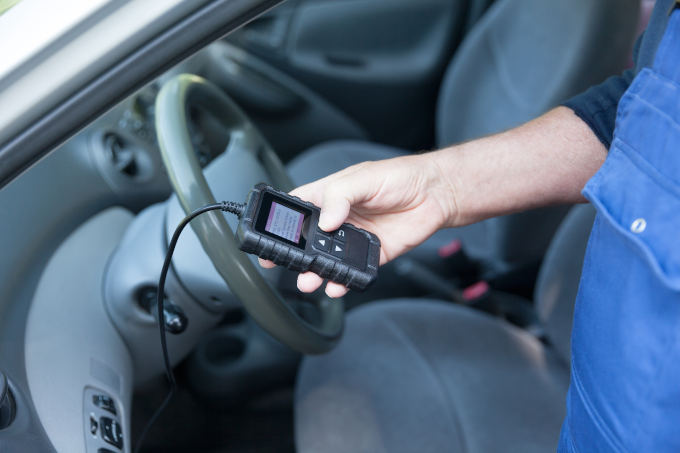Picture this: you’re driving down the open road, enjoying a little open-air freedom when, suddenly, a yellow light on your dashboard illuminates. You don’t know whether to stop and pull over right away, search for the nearest mechanic, or just ignore the light until you get home. Many people aren’t exactly sure what to do when their Check Engine Light comes on, but it is crucial to your car’s health that you do know. Here’s what you should do when your Check Engine Light comes on and why it’s essential to take these steps.
Never Ignore your Check Engine Light
Your Check Engine Light is a warning signal set off by the computer in your car, also known as the onboard diagnostics system. The computer finds a problem somewhere in the electronic-control system, so it turns on a light to tell you to take action.
The problem your Check Engine Light is referring to could be caused by many different things, from something as simple as a loose gas cap or the fluid sensor needing replacement to more complicated things like fuel and air metering systems problems.
If your Check Engine light appears and stays on steadily, it generally means your vehicle is safe to drive, but it should be taken to a repair facility soon.
If the symbol is blinking or flashing, this is generally indicative of a more serious problem. In this case, if you are driving, pull over at a safe location, shut off the engine, and have the car towed to a repair facility for diagnosis.
No matter what the light specifically means, don’t wait to address it. The longer you leave the light unchecked, the more problems your vehicle may end up with.
How the Onboard Diagnostics System (OBD-II) Works
The Check Engine Light is part of the Onboard Diagnostics System, often referred to as OBD-II. This computer system monitors all the diagnostics within your vehicle.
Along with this light, the computer also stores a “trouble code” in the memory to pinpoint the problem’s source. The light acts as a signal to the guide that will tell you what is wrong with your car, as there are hundreds of reasons a Check Engine Light might turn on.
To read the trouble codes, you need an OBD-II scanner, an electronic scan tool that reads and presents the codes. Auto repair shops have these tools handy, but they are also available for anyone looking to find and address their vehicle’s problems themselves.
Why Knowing How to Read Trouble Codes is Important
Because there is a multitude of codes that might come across the OBD scanner, learning to read and understand what the codes mean can be a little tricky. However, it’s the first step to diagnosing the problem, and it could potentially be something easy enough for you to address without a mechanic, saving you money and a trip to the shop. However, a professional opinion may be necessary, especially since the codes only point out where the problem is, not necessarily what it is.
Difference Between Global and Manufacturer Codes
The trouble codes consist of five characters, the first being a letter and the rest being numbers. “P” codes will be the ones that illuminate your Check Engine Light. The second character signifies whether it is a global code used by all vehicles or a manufacturer code — one specific to a particular make and model. Usually, a global code is signified by a “0”. In contrast, a manufacturer code is represented by a “1.” Below is a list of some of the most common global error codes for transmission issues.
Common Error Codes For Transmission Trouble
- P0218 – This code typically has to do with an overheating transmission. If it appears by itself, it likely means your fluid sensor is malfunctioning and needs to be replaced. If it appears with a series of other codes, the problem is more complex and should be addressed by a professional.
- P0613 – This code is for vehicles with automatic transmission and indicates an issue with the Transmission Control Module (TCM). This can affect your vehicle’s gear shifting abilities.
- P0614 – Again, this code is only for vehicles with automatic transmission. It means that the Engine Control Unit (ECU) and TCM aren’t communicating with each other. This can produce symptoms of stalling of the engine, difficulty shifting, or slow acceleration.
- P0700 – This code refers to a problem with the transmission control system and is accompanied by symptoms like engine stalling, poor gas mileage, and transmission shifting difficulty.
- P0706 – This code appears when your TCM, Power-train Control Module (PCM), or Transmission Range Sensor are not working correctly. This can result in decreased fuel economy, failure to shift properly, or the inability to go into gear. However, sometimes there are no noticeable symptoms.
- P0715 – Also known as the Input/Turbine Speed Sensor Circuit Malfunction, this code means the transmission control system cannot read the engine’s RPMs, resulting in possible gear shift failure. This code is specific to automatic transmissions.
- P0720 – This code occurs when the output speed sensor circuit, which controls shift scheduling, malfunctions. It might also mean the output RPM sensor and the input RPM sensor are not coordinating.
- P0729-P0736 – These codes concern problems with the gear ratio. They all indicate the same problem; their only difference is which gear they refer to that has the problem.
- P0750-P0770 – Like the codes above, each of these codes represents a particular gear problem, specifically a solenoid failure, which prevents the flow of transmission fluid into transmission hydraulics.
In short, don’t ignore the Check Engine Light. When it comes to vehicles, avoiding a potentially minor issue now can lead to more damage and a higher bill later. The AAMCO name is synonymous with trust and expert car care, handling the most complicated system in your vehicle. Our vehicle diagnostics expertise means we can quickly pinpoint what’s causing your Check Engine Light to come on, and we will recommend only what needs repair to save you time and money.
We're Here to Help
AAMCO has more than 60 years of experience diagnosing, servicing, and repairing more than 20 million vehicles. Customers rely on us for:
- Quality workmanship
- Expert Technicians
- Superior service
- Best warranty coverage available
- Trustworthy, honest service
AAMCO Centers of Southern California and surrounding areas represent trust, quality, and value. Call us today!

 Schedule Appointment
Schedule Appointment















